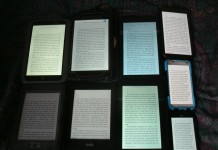 Trying to preempt Microsoft, Sony, the OpenReader Consortium and other threats, Adobe has previewed a new Flash-based reader called Digital Editions.
Trying to preempt Microsoft, Sony, the OpenReader Consortium and other threats, Adobe has previewed a new Flash-based reader called Digital Editions.
Adobe’s new reader can display not just PDF but also e-books using the still-evolving Open eBook Publication Structure standard. Beware, however—this reader is really a Trojan Horse for Adobe’s proprietary technology.
What’s more, Adobe is turning to the iPod approach in the way e-books will be managed on consumers’ machines, and I wouldn’t be surprised if a large Adobe e-book store materialized in time—to the disadvantage of independent retailers on the Net.
The final version of the new software will be out early next year and run on Windows, Mac and Linux machines and eventually various mobile devices. Text will reflow to allow the new software to work better on small-screened cell phones and PDAs, so you needn’t scroll from left to right to read all of a line. See a large screenshot of the Windows preview version.
Windows preview downloadable now
You can download a “pre-release” of the Windows version now and use it to read works by Philip Dick, Sir Arthur Conan Doyle and other authors. Adobe says that “Recommended system requirements for the Windows beta are Windows XP Service Pack 2, 500 MHz processor, 128MB RAM and a 1024×768 resolution screen.”
Mobi’s still more fun
The reflowability in the “early beta” is indeed a major step forward for Adobe. But the interface in the Windows preview is nothing to write home about, based on a very quick test spin. In such areas as navigation, Mobipocket still leads the brand-name e-readers.
Worse, the control area of the new Adobe reader’s screen, which uses a white text against a black background, displayed miserably on my mainstream system. I can’t see the “Find” rectangle to enter words. Turning up the brightness helped, but then the main text area was too bright. I’m running an HP a1250n Desktop PC with a 19-inch Acer LCD monitor (the AL1916), nothing exotic.
I like the fact that the Adobe reader reverts to a full screen display of the e-book you’re reading—after you’ve made adjustments, such as font changes—but all in all the Mobipocket experience still is superior to Adobe’s. Furthermore dotReader, the first OpenReader implementation, is on the way with a wealth of features not found so far in the new Adobe reader.
Deep in eBabel territory
What’s more, there are catches, major ones. Adobe as usual wants to make money off its proprietary DRM, meaning that for “protected” books, you’ll still be at the mercy of the company. I, wonder, too, about the heavy extent to which books for the new Adobe reader will rely on the company-controlled Flash format, as I feared it might. In practice, that will be a lot. Adobe even touts the reader software as “Flash-based.”
So, yes, we’re deep in Tower of eBabel territory.
The interactivity issue
Reportedly the Adobe reader will allow shared annotations. But I still wonder if the new software will permit the levels of interactivity possible in rivals such as OpenReader and Sophie. What about forums and even blogs being visible within e-books, for example?
I’m also curious about whether the new software will allow precise and reliable interbook linking. This has been one of the issues in the e-book standards controversy.
Adobe’s pokes at Microsoft and Sony
With Digital Editions, Adobe is taking pokes at Microsoft and Sony. Microsoft’s new Times Reader for newspapers—which is reflowable and offers elegant typography—is a preview of the successor to Microsoft Reader. Adobe is hoping that Digital Editions will prevail instead
In the past, Adobe has been serious about direct sales of e-books, and I wouldn’t be surprised if it used its readers’ capabilities to do this again—a potential threat not just to Sony but also to independent retailers on the Net, just as the Amazon–Mobipocket connection is. It will be interesting to see what the initial title count will be if a store materializes. Reviewers have complained that Sony’s 10,000+ titles are a mere drop in the bucket, although Adobe could do better because of its connections with the publishing industry. I don’t envy Sony. An Adobe store, if one materializes, could wreak havoc on Sony’s iPod strategy.
The IDPF angle: Hey, told you. There were reasons why Adobe suddenly discovered the standards religion and, along with ETI, more or less took over the International Digital Publishing Forum.
But is the new Adobe reader truly an example of genuine open standards? Hardly. Adobe is now invoking the IDPF name and “Open eBook Publication Structure.” But Adobe’s love of Flash—it must justify its expensive purchase of Macromedia—could very well muck things up. What’s more, as noted, the messy DRM issue will still get in in the way of people reading books from major publishers that insist on “protection”—the majority of the big boys. DRM will interfere with compatibility.
With or without DRM involved, however, Adobe is sending a rather mixed message in bragging about both the Open eBook and Flash standards. With Flash in the picture, we’re really talking in practice about another proprietary format. Adobe, in effect, for all its ballyhoo, has just given birth to another inhabitant of the Tower of eBabel. And here PDF was supposed to be a format for the ages. When will this silliness end? Adobe’s exploitation of the IDPF is yet another powerful argument for moving standards development to a more trustworthy body such as an OASIS-blessed technical committee.
Coming next, perhaps: Adobe-branded e-book hardware? I’ve raised that possibility before, and if it happens, I wonder if there could be an alliance with ETI, which is a hardware company and which miraculously joined Adobe in the revived standards initiative at the IDPF.
DRM details: My personal preference on DRM is simple: None in most cases. If DRM is used, I’d prefer an open approach. Next best choice would be DRM interoperabiity. Last choice would be a licensing arrangement with a company that agreed to keep costs down and let publishers, libraries and nonprofits administer DRM if they wanted.
Flash vs. SVG: To avoid proprietary traps, the open SVG standard (developed further if need be) would be far, far better than Flash.
Related: MobileRead, CNET, PDF Zone, and PC World.
And the standard reminder: I’m among the ringleaders of OpenReader.

































“With Flash in the picture, we’re really talking in practice about another proprietary format”
Are you frightened of any particular problem? I might be able to help.
(There’s now a proven way to display across multiple operating systems, multiple browsers, and increasingly multiple formfactors, but if there’s a way it may not work for all, then I’d like to know so it can be addressed, thanks.)
jd/adobe
Many thanks for your note, John. Adobe’s use of language such as “Flash-based” suggest that the Reader and Flash are intertwined even though, yes, it can read OEBPS books without Flash.
My concern is not so much over display on various browsers but the fact that Flash is controlled by one company, Adobe. Of course I highly applaud Adobe’s interest in a cross-platform approach—far, far superior to Microsoft’s Windows-centric approach.
And meanwhile, since I know you’ll be eager to address problems of the kind I mentioned, I need to add that my monitor’s model number is AL1916. I’ll stick that fact in the main post.
Regardless of our philosophical differences on formats, the best of luck with your new product. It is progress regardless of the negatives.
Thanks,
David
With Flash in the picture, you have possible audiovisual content as well.
Interest pointing, Larry, but you can do the same thing without a reliance on just one vendor vendor. Addressing one of these issues, I’ll add an SVG reference. Thanks. David
Ho. Interesting timing by Adobe. Doing the FUD Shuffle, perhaps? But I don’t see anything here that would prevent anyone — especially me! — from buying a Sony Reader.
A cheap and (let me say) propriety way of attracting people to your website. Sensationalizing by using keywords like “Trojan” is nothing new for people in want of attention. A fair analysis that outlines issues is more acceptable to me.
[…] Adobe Digital Editions–PDFs optimized for pocket devices: teleread review […]
I always liked this Flash plug-in for converting files
[…] also has Adobe Digital Editions, which can read .epub files. It’s also being ported to the Sony […]